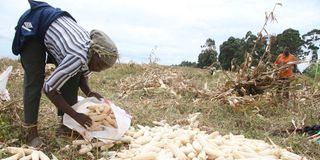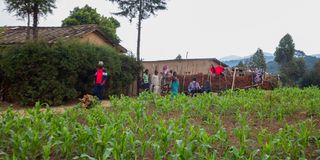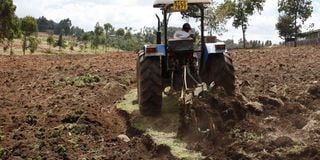
Then Agriculture Minister William Ruto (now President) admire a maize cob at the Kenya Seed Company's exhibition stand, at Eldoret Agricultural Society of Kenya show during the official opening on March 11, 2010.
|News
Premium
Maize maze: Down the memory lane of Kenya’s staple crop
What you need to know:
- At first, the white settlers exported all the produce that was planted locally, however, they later found out that it would be a cheaper alternative as food to their workers, and that is how it became popular with Kenyans to date.
- At least 80 percent of Kenyans are smallholders meaning they have less than five acres of land under which they plant maize.
- Land sub-division over the years has played a major role in reducing available land for farming.
- As such, maize production is under threat as more productive land is sub-divided for other use with an increase in population.
Before the advent of colonialism, millet and sorghum were the staple meal in Kenya’s households. Not anymore.
In the 19th century, the Portuguese traders along the Kenyan coast introduced maize for the first time in the country, since then, it has become a major staple in every household.
The crop was first domesticated by indigenous peoples in southern Mexico about 10,000 years ago and since then it has widely been grown the world over for different use, ranging from animal feed to staple meal.

Esther Gitau packs maize cobs into sacks during harvest on her rented farm at Kamukunji in Eldoret West District in this file photo.
Geographically, Kenya is a diverse country with many agroecological zones. The staple provides a basic diet to millions of people in Kenya.
From maize, Kenyans got ugali, and this has become such an important meal for the country, consumed by over 80 percent of the households.
Today, an average Kenyan consumes more than one bag of the staple annually. According to studies, per capita consumption has been rising over the years to now stand at 100 kilos per person from 70 kilos previously.
In fact, maize has become so popular that the once staple food like sorghum and millet have now been classified as orphaned crops, in the sense that they are scarce and not readily available.

The new variety can withstand drought stress and yield more than current varieties.
When maize was first introduced in the country, the British colonial deemed it as a commercial crop because of its potential, especially on the white highlands, hence expanding its scale in production.
At first, the white settlers exported all the produce that was planted locally, however, they later found out that it would be a cheaper alternative as food to their workers, and that is how it became popular with Kenyans to date.
In fact, this tradition is yet to be broken with most rich men, especially in rural settlements still paying part of their workers’ wages with maize as an alternative for money.
According to the Tegemeo Institute of Policy and Research, other crops such as rice and potato are also becoming important but are yet to break maize’s dominance.
“General increase in consumption of rice, wheat, plantain is substituting maize,” said Tegemeo in a research paper.
The Tegemeo think tank says Kenya has been touted as global maize “success story” for decades since the first hybrid variety-H611 was released on the eve of independence.
The hybrid, according to the Egerton-based institution, bares a unique, varietal hybrid with Ecuadorean and Kenyan parentage, diffused “at rates faster than among farmers in the US Corn Belt during the 1930s-1940s.
Be it as it may, policy researchers have more recently lamented that earlier gains in maize productivity have not lived up to their potential as production has not kept pace with demand, in large part driven by population growth, pushing up the country’s import bill.

Harvest in Trans Nzoia County, which expects a maize yield of 5.6 million bags. Uasin Gishu County projects to realise 4.5 million bags, of which 2.5 million will be released into the market.
Today, maize is grown all over the country even in regions that were not traditionally known for this crop, thanks to the research that has come up with a number of seed varieties that are suitable in different ecological zones.
However, Rift Valley remains the most important breadbasket for the country, accounting for over 80 percent of the total production. Trans-Nzoia and Uasin Gishu are the main growing zones, producing significantly huge volumes of the grain.
Maize has become so important that the lack of it in the country is declared a disaster, in fact, it is the only standard used in measuring food security in Kenya.
In the same weight, maize has remained a major cash crop for most farmers, especially in key growing zones, despite minimum returns in the last couple of years and advise from agriculture economists that growing the produce under five acres is not commercially viable.
Former Agriculture Principal Secretary Hamadi Boga says farmers need to grow other high-value crops if they have less than five acres of land.
Also read: Relief for farmers as maize import delayed
“Growing maize on less than five acres for commercial purposes is a poverty trap,” said Prof Boga.
At least 80 percent of Kenyans are smallholders meaning they have less than five acres of land under which they plant maize. Land sub-division over the years has played a major role in reducing available land for farming.
As such, maize production is under threat as more productive land is sub-divided for other use with an increase in population.

A tractor tills a farm in Elburgon, Nakuru County, on January 2, 2023, in preparation for the planting season. Farmers have started early preparation of their farms for the planting of short-term crops following the end of the Christmas and New Year festivities.
The government has given maize production priority with opening up of large tracts of land to private investors to enhance maize production amid annual shortages that has forced Kenya to rely on imports from other countries to meet the needs of Kenyans.
President William Ruto administration says high cost of input is what has put Kenya in the situation that it is at the moment- low production and increasing prices.
Dr Ruto has this year offered farmers subsidy on fertiliser, lowering the cost of the commodity from a high of Sh6,500 for a 50 kilo bag to Sh3,500.
“We can only cure the current shortages by addressing the cost of production, that is why my government is offering subsidies to farm inputs as opposed to subsidizing consumption,” said Dr Ruto.

Then Agriculture Minister William Ruto (now president) examines a specimen of infected maize during the Kenya stakeholders meeting on Biodiversity and Policy Formulation workshop held at the Laico Regency on March 15, 2010.
The crop, however, has become a victim of weather with production dwindling over the years, making the country food insecure.
Today, production per acre has dwindled from an average of 25 bags to just 15 if a farmer is lucky, with the decline attributed to a cocktail of things including the changing weather pattern.
Kenya is currently faced with one of the worst shortages in history following a poor crop in the 2022 season, occasioned by poor rains.
Despite increasing numbers of hybrids released to farmers over the years and grown by them over the past few decades, an older hybrid of 614 dominates on farms with scientist arguing that this coul;d be the reason for low yields.
“Hybrid 614 is the only variety that we know, it does better than any other of the hybrid seeds and it has the best test,” said Fredrick Muhorela, a farmer In Trans-Nzoia County.
Director General of Kenya Agriculture Livestock and Research Organisation (Kalro) Eliud Kireger agrees with the farmer that 614 is tastier and that that is one of the reasons why farmers are stuck with it for over three decades now.
“Farmers in Trans-Nzoia and Uasin Gishu Counties are stuck with this variety even though there are many others of high quality that have been certified by Kenya Plant Health Inspectorate Service (Kephis),” said Dr Kireger.
A recent research paper by Egerton-based institute tried to interrogate why farmers are not ready to embrace new varieties that are in the market.
“Is it that farmers see this hybrid as of superior quality to the more recent releases, or is it that the existence of counterfeit seeds in the market has made many farmers shy away from trying newer varieties to avoid the risk of selecting seeds that are not genuine?” asked the research paper.
The recently launched National Seed Policy recognises the need to counter the challenge of the existence of counterfeit seed in the market, and proposes establishment of mechanisms that encourage all registered seed merchants to join seed associations, for purposes of self-regulation to assure the distribution of quality seeds.
The study found out that the promotion and marketing of new seed varieties has been inadequate due to the cost involved.
“The existing regulations require seed merchants to appoint agents, sub-agents and stockists who must be licenced by Kephis to distribute and sell their seeds. These requirements have been cited as costly and increase the cost of seed to farmers,” notes the paper.
The study also finds out that production of maize in Kenya has been impacted negatively for lack of enought extension and information services supplied to farmers.
Scientists reckon that even with superior seed varieties available at affordable prices, productivity gains are only possible with proper agronomic management.
Kenya with relatively high adoption of improved seed among Sub-Saharan Africa, is yet to register the gains in production
“It is noteworthy that the prevailing extension system in the 1980s, the period in which the currently dominant hybrid was released, was the training and visit system, developed by the World Bank and promoted by national governments,” said the scholars.
Today, most of the extension officers who used to visit farmers in the yesteryears have retired and there are hardly any replacements, a thing that the Ministry of Agriculture has admitted.
Because of this, farmers have lacked relevant information, especially on good agronomic practices to help them improve their productivity.
It is against this backdrop that Kenya has for the last decade been depending on imports to bridge the ever-growing deficit in the country with most shipments coming in from Uganda and Tanzania.
This has seen the government open up a duty-free window to allow the importation of 10 million bags to cool off the runaway price of the staple that has seen a two-kilo packet of flour hit Sh200 on average.
The shortage, however, came as a blessing to farmers as for the first time in Kenya’s history, they have earned a historic high of Sh5,000 for a 90-kilo bag at the farm gate, thanks to a shortage in supply in the market.
Other than superior seed, optimal benefits also depend on other complementary inputs such as fertiliser. It is worth noting that the current shortage being experienced in Kenya accrued from expensive fertiliser last year, which saw many farmers opt not to use the supplement because of cost element.
The price of a 50 kilo bag of fertiliser for the first time in Kenya’s history shot to a high of Sh6,500, curtailing many farmers ability to purchase.
Unpredictable weather has made the cultivation of crops that require steady rainfall a dicey affair. But the abandoned crops give the farmers hope of earning a steady income while guaranteeing them food supply.
And it is because of that, that once referred to as orphaned crops, are making a comeback, not just as a means for income, but also as the preferred choice to ensure food security.
The total land area under maize production in the country is about 1.5 million hectares, with an annual average production estimated at three million tonnes, giving a national mean yield of two tonnes per hectare.
Typically, yields range from four to eight per hectare in the country’s breadbasket, representing only 50 percent of the potential of the hybrids.
Highland maize varieties are grown on some 40-50 percent of the total maize area, representing 600,000 – 800,000 hectares.
Constraints for maize production include drought, low soil fertility, pests and diseases. Foliar (leaf) and stalk/ear rot diseases and stem-borers, and lately, fall armyworm and lethal necrosis disease, cause great losses in maize production in the humid transitional and high tropics of Kenya.
According to Kalro, crop protectionists (entomologists, plant pathologists, and weed scientists) have put tremendous effort in identifying the disease and pest problems.
The incidence and severity of most of these pests and diseases can be reduced by chemical control methods ranging from seed dressing to foliar spraying; but host plant resistance provides the most economical management option, according to scientists.
Apart from Kenya, maize has become a staple food in many other parts of the world, with the total production of maize surpassing that of wheat and rice. It is consumed in the neighbouring countries of Uganda, Tanzania and Rwanda as ugali and in Malawi and Zambia as Nshima and pap in South Africa.
In addition to being consumed directly by humans, maize is also used for corn ethanol, animal feed and other maize products, such as corn starch and corn syrup.





